Create a Standard Branch Point
You can create standard branch points on the existing branch segment.
In the Branch Definition dialog box, click Segments Definition.
The Segments Definition dialog box appears:
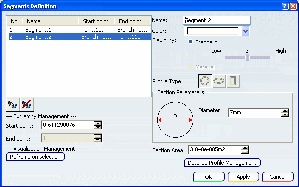
Click Add Branch Point  . .
Move the pointer over a segment to highlight the end, at which the reference point that lets you position your branch point will be placed.
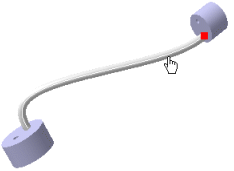
Select the segment.
The Branch Point dialog box appears.

The reference point is positioned at the end of the segment closest to your selection. A blue square visualizes the location of the branch point.
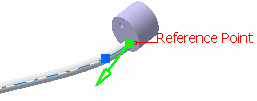
Optional:
Click Other Extremity to switch the reference point to the other end of the segment.
In the geometry area, move the blue square along the curve to a location, where you want to create the branch point.
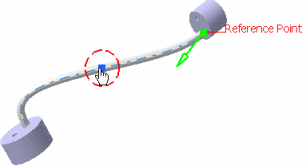
The distance to reference point is updated in the dialog box. Alternatively, set the distance in the dialog box by entering a:
- Length from the reference point
- Or, a segment ratio.
Click OK to validate. The branch point is created directly on the branch center curve. It is not an ordinary route point. This means that if you modify the center curve, the branch point will follow the curve. The branch is split into two segments. Tangent continuity is maintained between these segments. Segments share the same properties (those of the original branch) and center curve, and are stored in the same harness bundle. You can now set different segment properties for each segment or route a new segment that starts or ends at the branch point you have just created.

Create an Associative Branch Point
You can also create an associative branch point.
In the Branch Definition dialog box, click Segments Definition.
The Segments Definition dialog box appears:

Click Add Branch Point  . .
Select a segment.
The Branch Point dialog box appears.

The reference point is positioned at the end of the segment closest to your selection. A blue square visualizes the location of the branch point.
In the geometry area, move the blue square along the curve to a location, where you want to create the branch point.
The distance to reference point is updated in the dialog box. Alternatively, set the distance in the dialog box by entering a:
- Length from the reference point
- Or, a segment ratio.
Select the Associative tab:

The reference object must be a planar bi-dimensional element. You can also select the plane from several branch points.
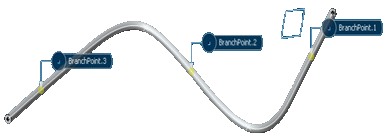
Note:
The associative branch point is based on the chosen plane. If the plane or the curve is modified, then the branch point is updated as long as it remains on the original segment. If the plane does not intersect with the branch, the branch point is no longer associative but standard.
Click OK to validate. The branch point is created directly on the branch center curve. It is not an ordinary route point. This means that if you modify the center curve, the branch point will follow the curve.

Edit Branch Points
You can edit branch points.
The Branch Point representation is an electrical feature. This object can be seen in the Edit > Find menu and in Knowledge tools.
Select a segment under a branch node.
Right-click the branch point representation and select Branch Point.
The Branch Point dialog box appears:

Notes:
|